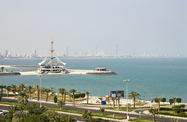Domestic and external pressures have made it a challenging year for the Jordanian economy, with most indicators pointing to 2013 being much the same, as the state seeks to curb spending, promote growth and maintain calm.
The year is closing much as it opened, with the government looking to reduce subsidies on fuel while having to deal with the burgeoning costs of supporting the tide of Syrian refugees fleeing the conflict across the border. These two factors have played on the economy throughout 2012 and are expected to continue into next year. Social unrest, in part spurred by rising prices of essential products but also in response to what the opposition claims is the slow pace of political and economic reforms, has made investors wary.
Despite these concerns, Jordan’s economy continued to expand, with growth expected to reach 3% by the end of 2012, according to the IMF, in line with the kingdom’s performance in the first half of the year. The IMF predicts GDP will increase by 3.5% in 2013, rising to 4.5% by 2017.
Given the difficulties under which the economy has laboured this year, a 3% rise in GDP should be considered an excellent result, as should the forecast for an inflation rate of 4.5% by the end of 2012, only slightly up from the 4.2% in the first three quarters of the year.
Inflation in 2013 could rise, however, as the impact of higher fuel costs kick in. In mid-November, the government cut subsidies on fuel, an IMF-mandated measure to allow Jordan to qualify for assistance worth $2bn. The step was also taken to help narrow the expected budget deficit, which Prime Minister Abdullah Ensour said could potentially expand to $5bn by the end of this year. However, in late November the budgetary shortfall was estimated at around $3bn, equivalent to 11% of GDP – still far above the projected $1.7bn.
The cost of subsidies rose sharply during the year after gas supplies from Egypt were disrupted because of sabotage to the pipeline linking the two countries. The severing of one of Jordan’s main energy supply routes necessitated a search for alternative sources. The supply cut also led the Kingdom to purchase oil, which is more expensive than gas, thus pushing up costs.
The announcement of the cut in subsidies sparked a series of protests, as had proposals to end price support earlier in 2012. The government has acknowledged the cut will cause hardships for some, and as a result, is introducing an assistance package that will provide direct payments to low-income earners.
While scaling back subsidies may help the government rein in costs, public debt will have risen substantially by the end of the year. According to data from the Ministry of Finance, state debt had climbed by 19% toward the end of 2012 to total $22bn, representing 72% of GDP. Of this total, roughly two-thirds had been raised on the domestic market, with the remaining owed to overseas lenders.
Concerns over regional and domestic instability have put pressure on Jordan’s foreign reserves, with holdings down by 34% since the beginning of 2012 to $6.85bn. These concerns have resulted in a move away from the dinar, with some investors shifting into overseas currencies as a hedge against further unrest. To counter this, the Central Bank of Jordan (CBJ) announced on December 3 that it was raising its overnight rate on dinar deposits to 4%, a 0.75% increase, with the aim of making investments in dinar-denominated assets more attractive. This may encourage more capital to flow into the market, though further unrest or negative reports on the economy in 2013 could erode any gains made through the CBJ’s intervention.
One of the biggest drains on the Jordanian economy has been the ongoing crisis in neighbouring Syria. As of December, the Kingdom was hosting more than 250,000 Syrian refugees, plus another 450,000 Iraqis, according to government estates, with international aid only covering a part of the increasing cost of accommodation, food and health care. The conflict in Syria has also negatively impacted Jordan’s external trade, with many of its export routes cut when Syria closed its borders. Additionally, tourism arrivals are down (even though earnings are up), with foreign visitors wary of travelling to a region close to the conflict.
The government will be hoping that general elections in late January will provide it with parliamentary support for its austerity programme. However, many opposition groups have vowed to boycott the poll over the issue of subsidy cuts, which could lead to further unrest in 2013.
If this were to happen, investors and donors may delay in committing funds, thus discouraging the government from focusing on reforms. In contrast, if the situation in Syria moves towards a resolution, and if political harmony is maintained at home, Jordan should be able to continue the steady rate of economic expansion forecast by the IMF and the government in 2013.

